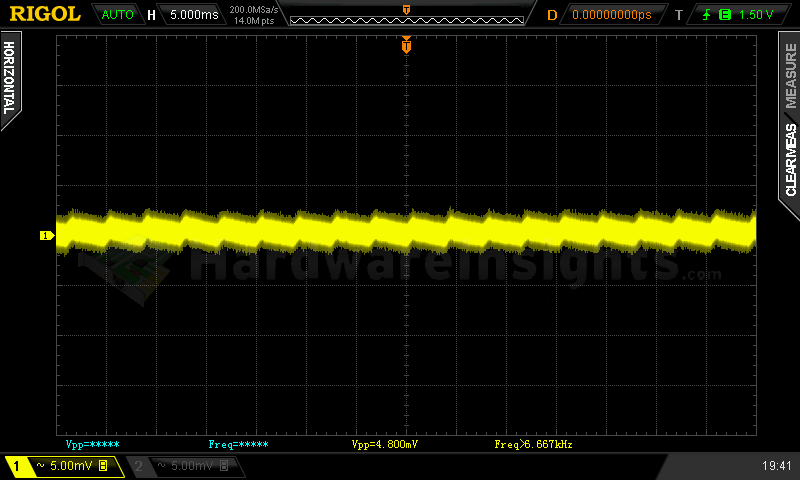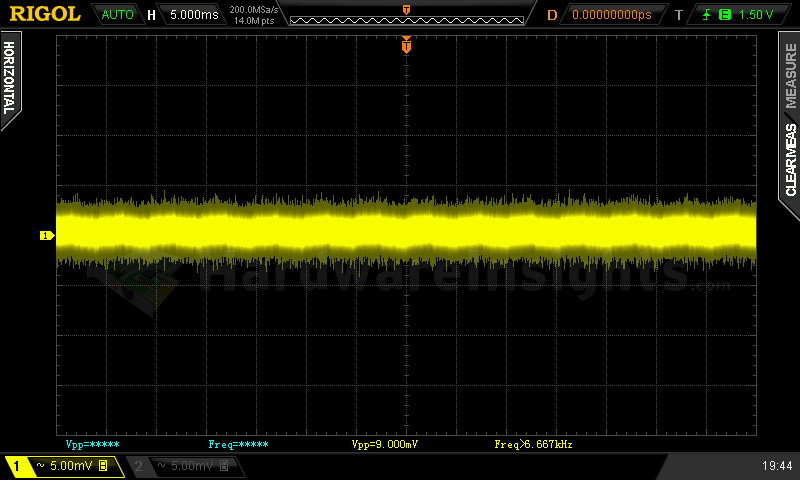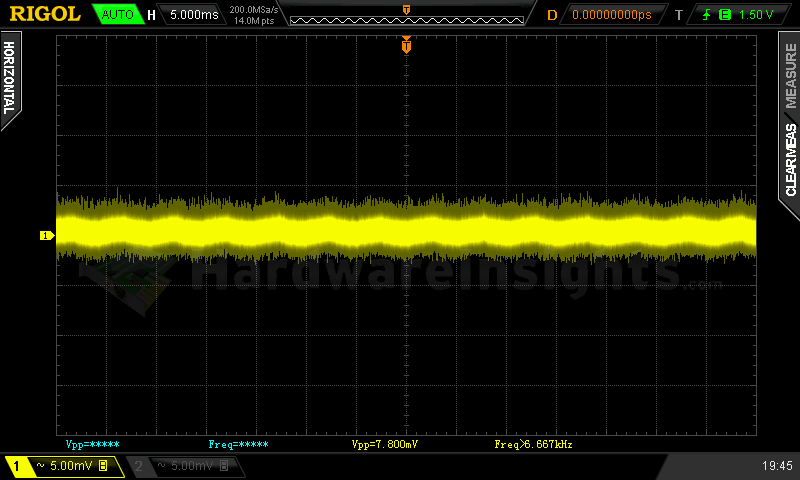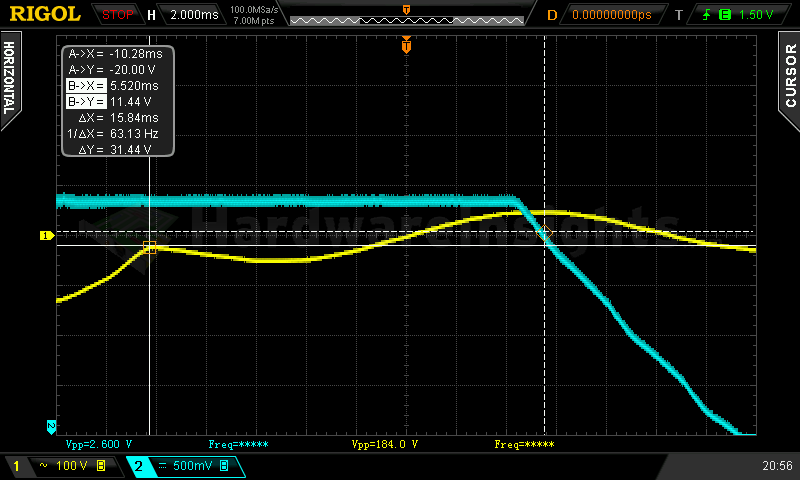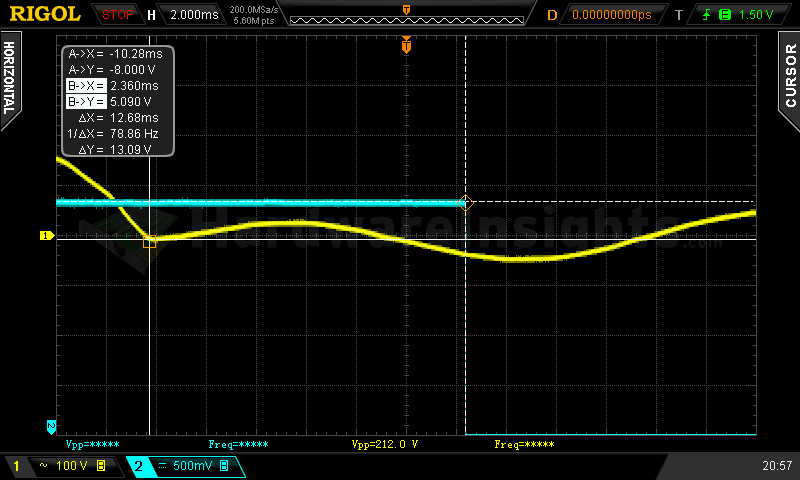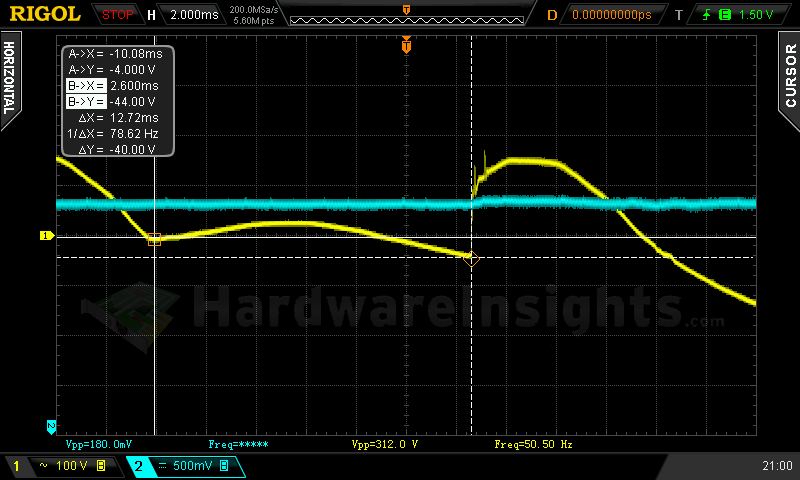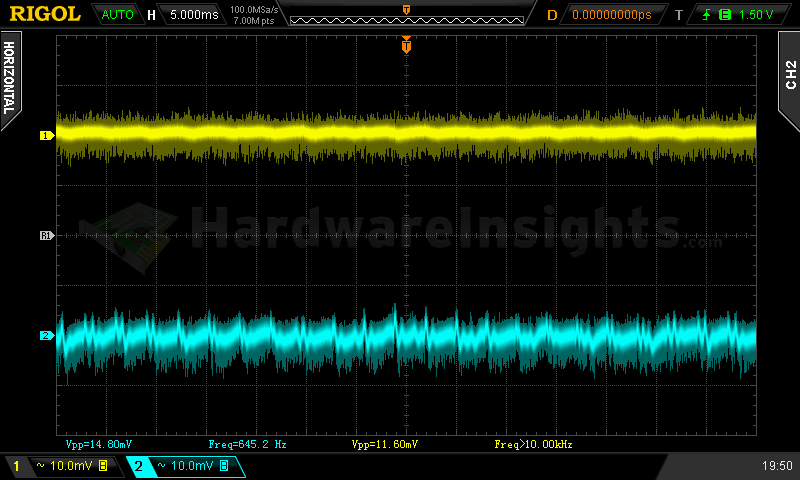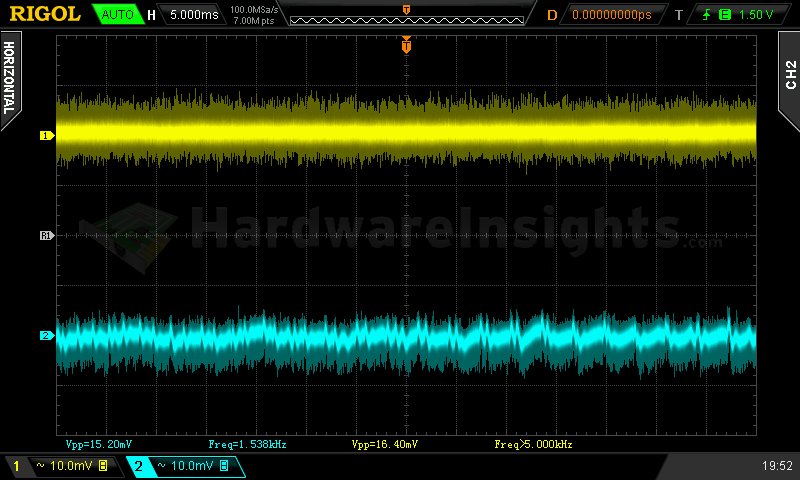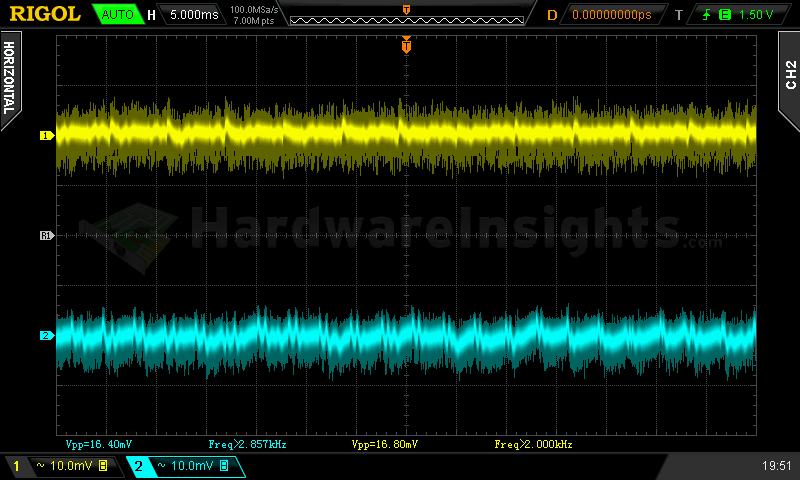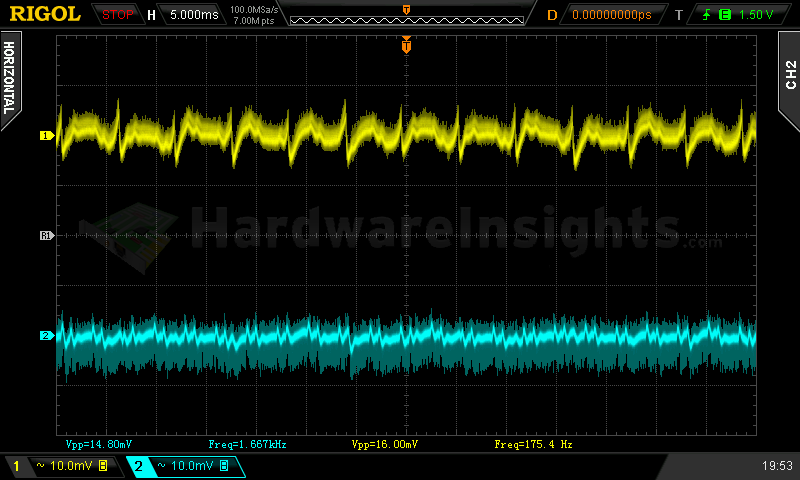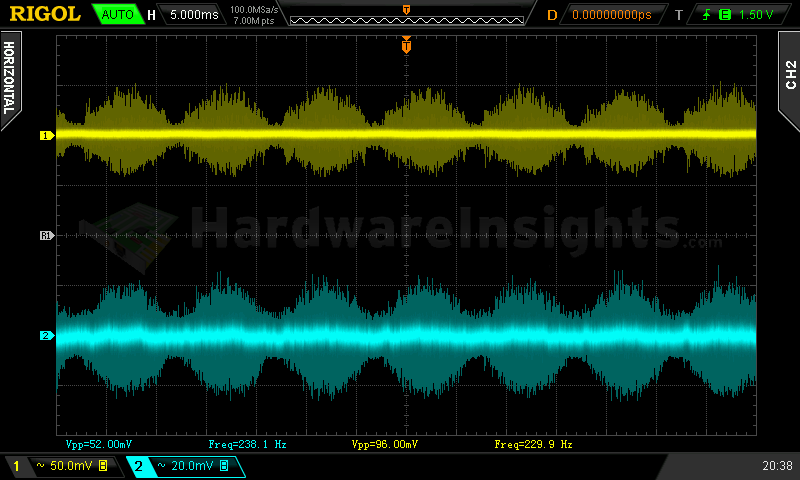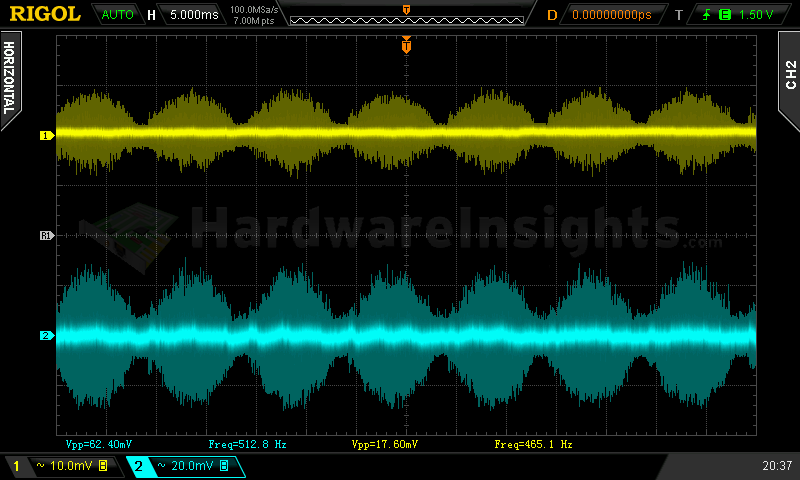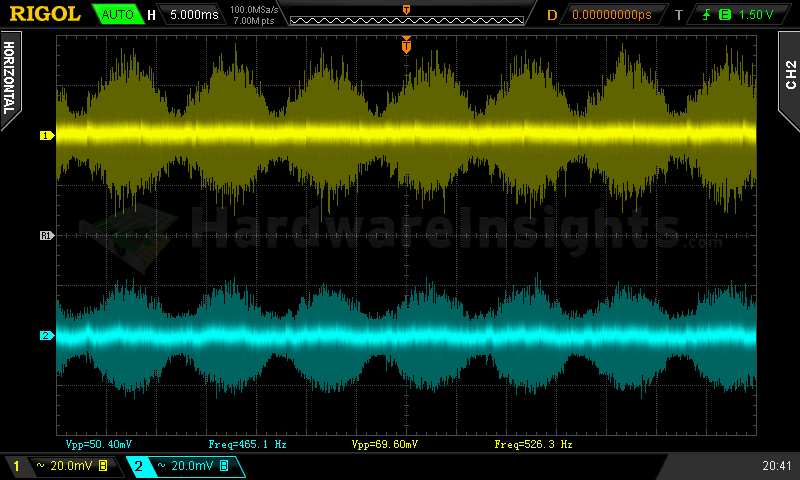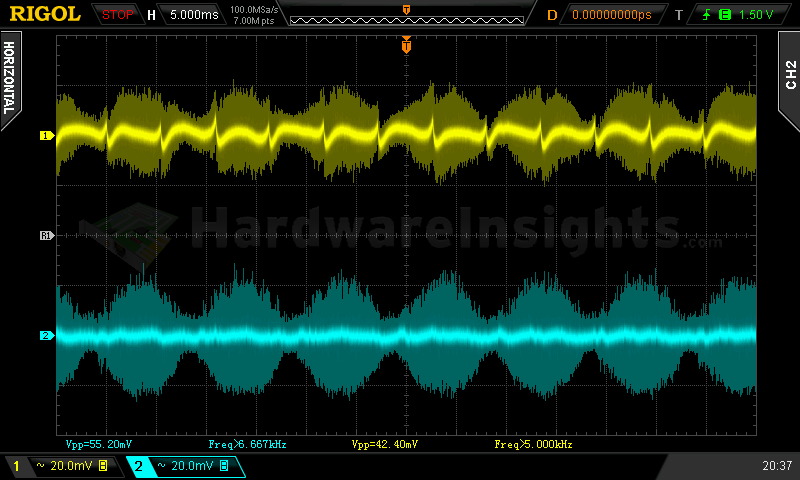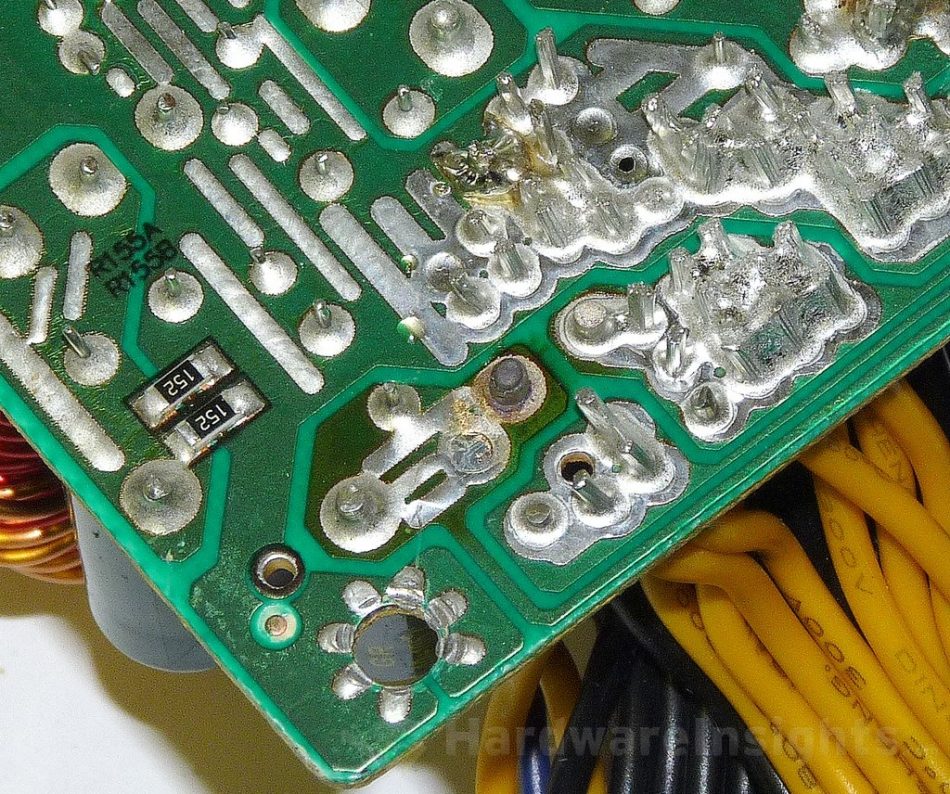Contents
- 1Introducing the Zalman ZM600-LX
- 1.1Packaging and accessories
- 2Connectors & cabling
- 2.1Casing & cooling
- 3Input filtering
- 4Primary side
- 4.1+5 V stand-by rail
- 5Secondary side
- 5.1Build quality
- 6Load testing
- 6.1Loading +5 V SB
- 6.2Hold-up time
- 6.3Combined loading
- 6.4Combined loading ripple
- 6.5Crossloading, overloading
- 6.6Crossloading, overloading ripple
- 6.7Fan speed, temperatures and noise
- 7Conclusion and evaluation
- 7.1Bonus
- 7.2Thanks
- 7.3Discussion
Load testing
Loading +5 V SB
As always, all load testing is done according to our testing methodology. The voltage regulation and ripple suppression are OK. Thanks to the Fairchild microchip the efficiency is reasonable too. Nothing great, but yeah, this is OK for the low-end.
| Output (W) | Load (A) | Voltage (V)/ ripple (mV) | Input (W) | Efficiency/power factor |
| 0 | 0 | 5.13/4.800 | 0.08 | —/0.017 |
| 9.86 | 1.95 | 5.07/9.000 | 13.97 | 70.6 %/0.442 |
| 17.29 | 3.45 | 5.07/7.800 | 24.92 | 69.4 %/0.502 |
+5 V SB ripple (left to right): 0 A; 1.91 A; 3.18 A
Hold-up time
As we can see on the oscilloscope screenshot, the hold-up time of the ZM600-LX +12 V rail is reasonably good at 15.84 ms, for the low-end that is.
The hold-up time of the power good signal is a bit shorter, at 12.68 ms.
While interrupting the power for a given time, I found that the +12V rail was barely affected by the drop. For the low-end this is OK, though it is still below the absolute ATX minimum. On the other hand, most of the low-end units we’ve reviewed so far didn’t even manage to supply their rated power…
Combined loading
Combined loading of the ZM600-LX was OK, which is slightly surprising in this price segment. The unit was able to deliver the rated power just fine, so lets talk about the voltage regulation first. In relative numbers, the largest drift from nominal was 2.6 %, which is good result for the price. Though in absolute numbers, this translates to a 0.37v drop on the +12 V rail which is not that great. But it is still well within spec.
| Output power | Load/ voltage +5 V SB | Load/ voltage +3.3 V | Load/ voltage +5 V | Load/ voltage +12 V | Load/ voltage −12 V | Input power | Efficiency/ power factor |
| 4.8 %/ 28.88 W | 0 A/ 5.13 V | 0.023 A/ 3.34 V | 0.340 A/ 5.07 V | 1.936 A/ 12.19 V | 0.294 A/ −11.83 V | 40.14 W | 71.2 %/ 0.851 |
| 20 %/ 117.56 W | 0.547 A/ 5.11 V | 3.08 A/ 3.34 V | 1.53 A/ 5.08 V | 7.69 A/ 12.12 V | 0.293 A/ −11.97 V | 143.1 W | 82.2 %/ 0.958 |
| 40 %/ 232.99 W | 1.05 A/ 5.09 V | 4.04 A/ 3.34 V | 2.2 A/ 5.10 V | 16.57 A/ 12.03 V | 0.298 A/ −12.08 V | 282.1 W | 82.6 %/ 0.971 |
| 60 %/ 357.30 W | 1.05 A/ 5.11 V | 5.45 A/ 3.35 V | 3.36 A/ 5.11 V | 26.2 A/ 11.94 V | 0.304 A/ −12.17 V | 434.9 W | 82.2 %/ 0.982 |
|
80 %/ 477.11 W |
1.56 A/ 5.08 V | 7.44 A/ 3.35 V | 4.84 A/ 5.11 V | 35.0 A/ 11.88 V | 0.304 A/ −12.28 V | 593.6 W | 80.4 %/ 0.988 |
| 100 %/ 604.78 W | 1.91 A/ 5.06 V | 10.11 A/ 3.35 V | 6.64 A/ 5.11 V | 44.3 A/ 11.82 V | 0.299 A/ −12.42 V | 774.7 W | 78.1 %/ 0.993 |
Even taking into account the average difference of calculated efficiency from my current equipment I would say the unit may not actually deliver its rated efficiency. At full load the efficiency drops to just under 80%, which is also corroborated by other sites (The Asian review site Playwares is one example). So while the result is not bad for the low-end, it may not provide the promised efficiency.
Combined loading ripple
This is common problem of all the low-end Zalman units I have seen so far (GS, LE) and the ZM600-LX is no exception. The ripple tends to skyrocket at full load. Though it was not so drastic this time as it was previously, as it seems that Hui Cheng is making some progress, we are still quite a bit out of spec. So the ZM600-LX fails here. You can notice the ripple basically follows the rectified sine wave with the chunks being 10 ms long (or 100Hz). I think I might try inserting a bigger input filter capacitor, maybe it will be enough for the ripple to go down significantly.
| Output % | Ripple +5 V SB | Ripple +3.3 V | Ripple +5 V | Ripple +12 V | Ripple −12 V |
| 4.8 | 11.60 mV | 16.40 mV | 18.80 mV | 16.40 mV | 16.00 mV |
| 20 | 18.80 mV | 20.40 mV | 16.00 mV | 22.80 mV | 18.00 mV |
| 40 | 21.60 mV | 16.40 mV | 20.80 mV | 26.80 mV | 27.60 mV |
| 60 | 31.20 mV | 14.00 mV | 28.00 mV | 24.80 mV | 27.20 mV |
| 80 | 98.00 mV | 44.80 mV | 36.00 mV | 41.60 mV | 46.40 mV |
| 100 | 96.00 mV | 17.60 mV | 69.60 mV | 62.40 mV | 42.40 mV |
Ripple 4.8% load (left to right): +5 V SB; +3.3 V; +5 V; −12 V. The second channel is connected to +12 V.
Ripple 100% load (left to right): +5 V SB; +3.3 V; +5 V; −12 V. The second channel is connected to +12 V.
Crossloading, overloading
As this is ordinary group-design platform, the crossloading is expected to be mediocre at best. And indeed, with a slightly below maximum load on the +5 V rail, the +12 V skyrocketed to 12.71 V while the +5V rail itself still had some margin to decrease. Putting another 20 watts on the +12 V rail did not make it go in spec. Based on the ATX 2.2 regulation diagram for a 450W unit, while it may not deliver ~81 W from +3.3/+5 V combined with 26 W +12V output, it definitely should with 46+ W at +12 V, and it did not. Fail again!
| Output power | Load/ voltage +5 V SB | Load/ voltage +3.3 V | Load/ voltage +5 V | Load/ voltage +12 V | Load/ voltage −12 V | Input power | Efficiency/ power factor |
| 19 %/ 116.98 W | 0.554 A/ 5.11 V | 23.5 A/ 3.34 V | 1.535 A/ 5.02 V | 1.987 A/ 12.32 V | 0.290 A/ −11.99 V | 167.2 W | 70.0 %/ 0.961 |
| 19 %/ 113.70 W | 0.551 A/ 5.11 V | 1.455 A/ 3.35 V | 15.8 A/ 4.84 V | 2.054 A/ 12.71 V | 0.290 A/ −12.35 V | 144.7 W | 78.6 %/ 0.956 |
| 89 %/ 535.65 W | 0.563 A/ 5.11 V | 1.430 A/ 3.35 V | 1.461 A/ 5.22 V | 44.7 A/ 11.56 V | 0.298 A/ −12.18 V | 679.8 W | 78.6 %/ 0.990 |
| 119 %/ 711.27 W | 3.20 A/ 5.02 V | 22.4 A/ 3.34 V | 15.7 A/ 4.96 V | 44.3 A/ 12.16 V | 0.300A/ −12.79 V | 948.1 W | 78.8 %/ 0.995 |
Crossloading other rails went OK. What was actually also OK was that the advertised protections seem to work. At least on the +5 and +12 V rails that is, and from the +3.3 V rail I only managed to draw just about the rated power because of the limitations of my equipment. The unit shut down with about 19 A @5 V. As for the +12 V rail, this proved to be somewhat of a problem – I barely managed to draw 45 amps from the ZM600-LX. Here the protection seemed to be set way too tightly. Upon opening the unit for a recap I found the reason: The current shunt was very poorly soldered which resulted in extreme overheating. So extreme in fact that it caused the solder to oxidise and the copper pad became noticeably discoloured. And only after just about an hour under high load!
As for overloading the ZM600-LX, the best I managed to get was about 710 W. As I am limited in maximum output draw from the +3.3 V rail, and the other two rails are limited by the OCP, adding any more draw to them resulted in an immediate shutdown. I cannot confirm if the OPP is actually working, but the OCP seems to be doing a good job preventing any overload by itself. With the shunt problem gone, the OCP on the +12V rail reacted at about 50 A. I have not tested the OPP but either the unit is able to deliver 750 W before you run into the OCP limits, or the OPP kicks in slightly before that. All in all I would call the protections OK. But only if the components are soldered properly in the first place. This is an excellent example of the effects of bad soldering…
Crossloading, overloading ripple
Crossloading ripple was a similar story, though under overload, with a higher output from all rails, the problems were only visible on a much smaller scale. But out of spec nonetheless.
| Output % | Ripple +5 V SB | Ripple +3.3 V | Ripple +5 V | Ripple +12 V | Ripple −12 V |
| 19 | 10.80 mV | 28.00 mV | 29.60 mV | 37.60 mV | 28.00 mV |
| 19 | 24.00 mV | 7.60 mV | 23.60 mV | 21.60 mV | 21.20 mV |
| 89 | 46.80 mV | 37.60 mV | 53.60 mV | 44.80 mV | 22.00 mV |
| 119 | 58.40 mV | – | – | 41.60 mV | – |
Fan speed, temperatures and noise
The fan inside the Zalman ZM600-LX started spinning right when the unit powered on. It starts at already quite a high speed of almost 1100 RPM, and during overloading the unit managed to push the speed to as high as 2300 RPM. This unit is not silent at all, as even at minimum speed the fan is audible. At around 1500 RPM is starts to become loud, and at around 2000 RPM it is very loud.
| Output % | Fan speed (RPM) | Temperature intake/ outtake | Noise (dBA) |
| 4.8 | 1087 | 23 °C/ 23 °C | 39.6 |
| 20 | 1103 | 24 °C/ 28 °C | 39.6 |
| 40 | 1115 | 25 °C/ 35 °C | 39.6 |
| 60 | 1234 | 26 °C/ 38 °C | 39.8 |
| 80 | 1686 | 27 °C/ 44 °C | 43.4 |
| 100 | 1980 | 28 °C/ 54 °C | 45.8 |
| CL 19 | 1438 | 26 °C/ 37 °C | 41.1 |
| CL 19 | 1087 | 24 °C/ 32 °C | 39.6 |
| CL 89 | 1591 | 27 °C/ 53 °C | 42.5 |
| OL 119 | 2289 | 29 °C/ 53 °C | 48.9 |
Despite that, the unit still runs hot, which makes sense because of the low efficiency at just between 80–85 %. And on top of that, Zalman pushes quite a lot of power in a small chassis. I had serious concerns whether it would actually survive the Sweater contest, but fortunately it did. After 15 minutes it was incredibly hot, and the temperature of the exhausting air reached over 60 °C. If you ever have to use the LX series, keep the case well cooled and don’t push the unit to its rated power. With those garbage capacitors, it really isn’t a good idea.
